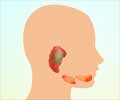Diagnosis
Diagnostic evaluation of salivary gland cancer begins with a detailed physical examination and the elicitation of a proper medical history. The doctor examines your head, neck, mouth, and throat. An examination from inside the mouth is required sometimes to feel the lump.
Fine Needle Aspiration (FNA) Biopsy: A sample of tissue or fluid is removed using a thin needle and examined under a microscope to look for cancer cells. This is done by a pathologist.
Imaging modalities like MRI (magnetic resonance imaging) and CT scans are also employed when needed.
An endoscope (a thin, tube-like instrument) is sometimes inserted into the mouth to look at the mouth, throat, and larynx for proper visualisation.
Ultrasound examination and PET scans (positron emission tomography scans) may also be indicated.
A detailed search for further spread, i.e. distant metastases in the lung, liver, bone, or brain is sometimes required before initiating treatment in a malignant cancer.









